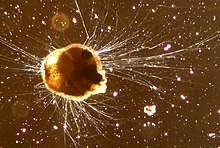Rhizaria
| Rhizaria Temporal range:
| |
|---|---|

| |
| Ammonia tepida (Foraminifera) | |
| Scientific classification | |
| Domain: | Eukaryota |
| Clade: | Diaphoretickes |
| Clade: | TSAR
|
| Clade: | SAR |
| Clade: | Rhizaria Cavalier-Smith , 2002
|
| Phyla[2] | |
The Rhizaria are a diverse and species-rich supergroup of mostly
Groups
The three main groups of Rhizaria are:[8]
- Cercozoa – various amoebae and flagellates, usually with filose pseudopods and common in soil
- Foraminifera – amoeboids with reticulose pseudopods, common as marine benthos
- axopods, common as marine plankton
A few other groups may be included in the Cercozoa, but some trees appear closer to the Foraminifera. These are the Phytomyxea and Ascetosporea, parasites of plants and animals, respectively, and the peculiar amoeba Gromia. The different groups of Rhizaria are considered close relatives based mainly on genetic similarities, and have been regarded as an extension of the Cercozoa. The name Rhizaria for the expanded group was introduced by Cavalier-Smith in 2002,[9] who also included the centrohelids and Apusozoa.
A noteworthy order that belongs to
History
Similarities between various Rhizaria organisms have been noticed since the 19th century. In his 1861 classification of the
Evolutionary relationships
Rhizaria are part of the SAR supergroup (Stramenopiles, Alveolates, Rhizaria), a grouping that had been presaged in 1993 through a study of mitochondrial morphologies.[14] SAR is currently placed in the Diaphoretickes along with Archaeplastida, Cryptista, Haptista, and several minor clades.
Historically, many rhizarians were considered
Phylogeny
Rhizaria is a
SAR Supergroup
|
| ||||||||||||||||||||||||||||||||||||||||||||||||||||||||||||||||||||||||
Sexual cycle
Complete sexual life cycles have been demonstrated for two lineages (Foraminifera and Gromia) and direct evidence for karyogamy or meiosis has been observed in five lineages (Euglyphida, Thecofilosea, Chlorarachniophyta, Plasmodiophorida and Phaeodarea).[21] In particular, the Foramanifera are marine amoebae that are defined by a dynamic network of pseudopodia, and the production of intricate shells.[21] These amoeba have complex sexual life cycles with meiosis and gamete production occurring at separate stages.[21]
References
- ^ PMID 29666938.
- Wikidata Q57086550.
- ^ Taylor, Christopher (2004). "Rhizaria". Archived from the original on 2009-04-20.
- PMID 15148395.
- S2CID 1387879.
- .
- ^ Caron, D. (2016). The rise of Rhizaria. Nature (London), 532(7600), 444–445. https://doi.org/10.1038/nature17892
- PMID 17174576.
- PMID 11931142. Retrieved 2007-06-08.
- S2CID 17180719.
- PMID 11558731.
- ^ Carpenter, William Benjamin (1861). "XLVII.-On the systematic arrangement of the Rhizopoda". Natural History Review (Dublin and London). 1 (4): 478.
- .
- ^ Seravin LN. Osnovnye tipy i formy tonkogo stroeniia krist mitokhondriĭ: stepen' ikh évoliutsionnoĭ stabil'nosti (sposobnost' k morfologicheskim transformatsiiam) [The basic types and forms of the fine structure of mitochondrial cristae: the degree of their evolutionary stability (capacity for morphological transformations)]. Tsitologiia. 1993;35(4):3-34. Russian. PMID 8328023.
- PMID 17726520.
- PMID 18522922.
- S2CID 71148672.
- PMID 18952499.
- PMID 21295519.
- S2CID 52982396.
- ^ a b c Lahr DJ, Parfrey LW, Mitchell EA, Katz LA, Lara E. The chastity of amoebae: re-evaluating evidence for sex in amoeboid organisms. Proc Biol Sci. 2011 Jul 22;278(1715):2081-90. doi: 10.1098/rspb.2011.0289. Epub 2011 Mar 23. PMID 21429931; PMCID: PMC3107637
External links
- Rhizaria at UniEuk Taxonomy Map
- Molecular Phylogeny of Amoeboid Protists - Tree of Rhizaria
- Tree of Life Eukaryota




